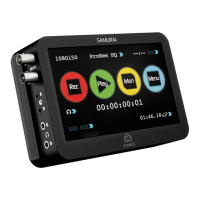
Do you have a question about the Atomos Samurai and is the answer not in the manual?
| Display | 5-inch LCD |
|---|---|
| Recording Format | Apple ProRes, Avid DNxHD |
| Inputs | HDMI, SDI |
| Outputs | HDMI, SDI |
| Video Input | HDMI, SDI |
| Video Output | HDMI, SDI |
| Storage | 2.5-inch SSD/HDD |
| Audio Input | HDMI, SDI |
| Audio Output | 3.5mm jack |
| Supported Codecs | ProRes 422, ProRes LT, DNxHD |
Safe handling and usage of batteries and power supplies for the Samurai unit.
Precautions for safe operation and handling of the Samurai device to prevent injury or damage.
Guidelines for handling and protecting sensitive disk drives from damage.
Information on SDI cable usage, hazards, and locking connectors.
Warning about small parts in the Samurai carry-case posing a choking hazard.
Copyright notice, disclaimer, and registered trademarks of ATOMOS and other companies.
Details of the hardware warranty period, coverage, and limitations.
Specific conditions and causes not covered by the ATOMOS warranty.
Introduction to the End User License Agreement for ATOMOS software.
Defines eligibility, license grant, and prohibited actions for ATOMOS software.
Welcome message and overview of the Atomos Samurai's capabilities and benefits.
Explains technological advancements and the advantages of ProRes/DNxHD codecs.
Describes the intuitive interface and information about regular software updates.
Details what is included with the Samurai system and what additional items are needed.
Lists all the components and accessories included in the Samurai package.
Information about free extra cables and adapters upon product registration.
Information on using 2.5" spinning disks and Solid State Drives (SSDs) with the Samurai.
Guidelines for selecting drives, handling them during operation, and considering shock/vibration.
Importance of backing up recorded content and strategies for archiving.
Information about SDI cables, their robustness, and potential trip hazards.
Guidance on selecting a suitable 1/4" screw mount for the Samurai.
Step-by-step instructions for inserting and securing a disk into the Master Caddy.
Crucial warning about static electricity damaging disk connectors.
Instructions for battery installation, charging, Battery Looping, and external power compatibility.
Procedures for powering on and off the Samurai unit.
Description of various connection ports including Master Caddy, HD-SDI, LANC, and Audio.
Location, insertion, and removal instructions for the Master Disk Caddies.
Details standard 1/4" screw mounts and the Samurai's modular design.
Overview of timecode support, triggering, and available modes (HD-SDI, Time of Day, Record Run, Auto Restart).
Explanation of pulldown, detection methods, and procedures for different frame rates.
Overview of the intuitive interface, touchscreen, and main screen layout.
Details on starting/stopping recording, choosing formats, and matching camera settings.
Information on using HD-SDI Time Code Trigger and LANC for remote recording.
Instructions on using the core control buttons for recording, monitoring, playback, and menu access.
Managing scene/shot numbers, adjusting date/time, and display options.
Displaying input status and changing video compression formats.
Details about the optional Avid DNxHD upgrade availability.
Understanding battery status, storage capacity, and the Batteries screen.
How automatic battery switching works and setting the unit name.
Enabling recording to be triggered by HD-SDI timecode.
Accessing audio monitoring levels and selecting audio sources for recording.
Adjusting line out level and understanding audio output during playback.
Steps to connect input signals and essential checks before recording.
Methods for starting recording and understanding recording status indicators.
Utilizing the Samurai's screen as a field monitor and exploring assist features.
Explanation of Anti-Shock technology and the "Skippy" warning indicator.
Explains unitname, scene, shot, and take naming for organizing footage.
Details about the exFAT file system and its compatibility.
How to connect to computers, supported NLEs, and exFAT compatibility.
Details about the docking station and procedures for transferring files.
General guide for importing footage and specific steps for Final Cut Pro.
Overview of playback capabilities and its function as a portable HD deck.
How playback works with different file systems and their respective structures.
Explanation of scrub bar, play/pause, and clip navigation controls.
Details on fast playback modes, frame-by-frame, and headphone volume.
How the Samurai handles interlaced footage during playback and stopping.
Using D-Tap and AC adapters for external power supply to the Samurai.
Capabilities of Connect Converters for adding HDMI input/output.
Guides for using Connect H2S and S2H converters for signal conversion.
Step-by-step guide to update the Samurai's firmware.
Troubleshooting guide for firmware issues and the built-in recovery mechanism.
Details on the main unit's physical and power specs, and battery compatibility.
Specifications for supported video formats, input/output signals, and audio channels.
Information on recording times, codecs, pulldown processing, and remote control options.
Details on disk drive compatibility, supported software, included/optional accessories, and mounting.
Information on operating temperatures, heat sinks, and best practices for drive usage.